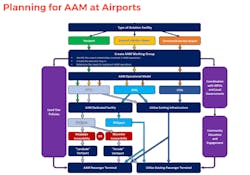Advanced Air Mobility (AAM) and Urban Air Mobility (UAM) have dominated the lexicon of aviation leaders for a decade. The concept has morphed from drones and unmanned aircraft into different concepts in recent years.
The aircraft and business models are still elusive to real life service, but airport leaders are taking real steps now to address this future mode of aviation even when the details keep changing.
WSP USA Vice President for Aviation Planning and Senior Technical Principal Gaël Le Bris is a leader in helping airports plan for this unknown impact to their operations. He sat down with Airport Business to discuss real life examples of progress and what airports will be impacted by the next generation of mobility.
Airport Business: Why is advanced air mobility (AAM) something North American Airports need to care about right now?
Gaël Le Bris: We’re literally at the verge of having the first electric aircraft being certified for the transport of passengers. When we talk about AAM, we need to look at what we mean. Electric aircraft is a technology. Advance air mobility is a way to leverage that technology a certain way along with other things to provide a new way to fly.
There are two different opportunities that are extremely interesting for airports and not only large hub airports. When we talk about urban air mobility (UAM), we're talking about using these EVTOLs to address a part of the complexity of airport ground access from downtowns to commercial service airports. Literally flying over the congestion. That's also great opportunity for smaller airports to provide point-to-point on-demand service within large metropolitan areas. Small and regional airports can provide intercity connections either on demand or through regularly schedule regular service.
AB: Airports are already taxed with infrastructure needs for current technology. Are we prepared for AAM?
GL: No. We're getting there, but we're not ready. Now is the time where we need to as the broader aviation community ask ourselves these questions. How do we need to accommodate these aircraft at airports? What do we need to do in terms of infrastructure? What is the plan at individual aviation facilities to achieve that?
It's the right time because we see that certification is on the horizon. We see a lot of interest for from different flight operators. It's the right time to ask ourselves how we develop the infrastructure, and not only the brick-and-mortar infrastructure, but the whole infrastructure in order to incorporate these things into aviation systems.
Each airport is different. Are we talking about a landside vertiport located on top of a parking garage? Or are we talking about accommodating these things on the existing runways? Do we need a separate terminal for that? What about utilities? The electric infrastructure is a very exciting conversation because it's not just installing electric chargers on the ramp. It's literally rethinking how we produce store and distribute energy at airports. If we turn electricity into a fuel, and not only for aircraft, it's also for electric vehicles on surveillance side terminals, everything is getting electric with the electrification of everything.
At some point, we need to ask ourselves, how do we provide all these megawatts and megawatt hours to the final aviation users? How can we be more resilient? And maybe part of the solution is producing electricity at the airport. If airports start producing electricity, storing electricity, becoming more resilient in returns, they can be leveraged as great tools within communities.
AB: So microgrids need to be part of this conversation?
GL: Absolutely. Microgrids and some of these electric aircraft could be fuel cell electric, so it's also about hydrogen. When it comes to electricity, it's thinking about microgrids, how to produce electricity at the airport and how to distribute it to the final user. Sometimes I hear it’s going to be easy to electrify aviation because utility providers know how to bring additional megawatts to a user. That's true, but airports need to adapt and upgrade their electrical systems, create new substations on the ramp and so on. That costs a lot of money. There’s a bit of capital improvement projects to plan for and some work to do on the electrical infrastructure side at airports in order to bring all of that to the final aviation user’s aircraft on the ramp waiting for being recharged.
AB: Tell me about the plans you’re involved with to introduce a vertiport into Philadelphia International Airport and the goals with the project.
GL: We’re working on the airport master plan upgrade for Philadelphia International Airport. We’re considering the future of aviation demand. The transition to AAM is on the horizon and it’s going to emerge soon. We know that it could emerge with various types of aircraft and demand could skyrocket depending on the operating cost of the aircraft.
You don't have a flight operator ready to operate AAM at a specific airport and if you look at the FAA Terminal Area Forecast, or even the aerospace forecast, you don't have anything about AAM. However, when you do a master plan for a commercial service airport with a planning horizon of 2040, you need to have that conversation about AAM. In order to solve that equation, instead of having a quantitative activity forecast, we developed a few planning scenarios based on realistic level of demand. And based on that, we developed some conceptual vertiports that are scalable.
At PHL, we're talking about UAM to fly from downtown Philadelphia and the greater Philadelphia area to the airport. Depending on what happens with demand, you can implement a different size of vertiport. In terms of placement, we considered a new ground transportation center along the terminal area that consolidates all the needs in terms of parking, ground transportation etc. The roof of that facility is perfectly located for accommodating a vertiport facility.
AB: Airports like Philadelphia definitely need this infrastructure inside their master plans, but will implementing AAM or UAM take a larger consortium from across the region?
GL: As of today, we don't know because we don't have a clear idea of the level of activity of AAM in the coming years, because there are so many question marks. You have different levels of demand which trigger different facility requirements that are going to drive the cost of the facility and influencing the kind of business models of vertiports.
In the specific case of Philadelphia, we're not discussing any of that. What we're saying is let's make sure that we can accommodate these different scenarios at the airport, depending on what's going to happen, and make sure that we don’t hinder the emergence of UAM activity at PHL. We’re drawing a box that is protected in order to make sure that we can fit the vertiport regardless of the, of the level of demand.
AB: How does a vertiport geared towards AAM and UAM traffic differ from a traditional vertiport?
GL: At a high level they look alike, but if you dig down a bit they’re very different. If you look at helicopter transportation today, we have relatively low intensity operations with a small community of experienced pilots flying mature technologies. If you look at AAM or UAM, we’re talking about potentially high intensity operations across urban areas with a new type of aircraft and new pilots. We need to reinvent the way we provide vertical flight in order to provide that kind of point-to-point on-demand mobility. You’ll see a broad variety of facilities from small vertiports that look a lot like existing helipads and vertiports that are more complex with a small terminal facility, different types of amenities, more integration with ground transportation, maybe even maintenance and repair services and FBOs.
AB: You said this isn’t just an issue for large hub airport likes Philadelphia. What other kinds of airports need to prepare for AAM now?
GL: Everyone needs to ask themselves what’s going to happen at their airport with AAM. Large airports might think UAM is a no-brainer because it’s going to provide airport access, but smaller facilities might be easier to access because there’s extra capacity available.
Small community airports could see AAM as an opportunity to provide on-demand or scheduled service to increase connectivity to larger transportation hubs. It provides an opportunity to reinvent the kind of regional aviation we had in past decades.
AB: What do airport leaders need to think about right now to ensure they’re prepared for AAM when it takes off?
GL: We need to educate ourselves about what’s coming in order to understand the complexity of all these issues. I think we’re living through the most exciting period in aviation history. Everything is changing, so aviation and airport leaders need to educate themselves about what’s coming and make sure they’re involved in that thought leadership process.
About the Author
Joe Petrie
Editor & Chief
Joe Petrie is the Editorial Director for the Endeavor Aviation Group.
Joe has spent the past 20 years writing about the most cutting-edge topics related to transportation and policy in a variety of sectors with an emphasis on transportation issues for the past 15 years.
Contact: Joe Petrie
Editor & Chief | Airport Business
+1-920-568-8399
>> To download the AviationPros media kits, visit: Marketing Resource Center
>>Check out our aviation magazines: Ground Support Worldwide | Airport Business | Aircraft Maintenance Technology

